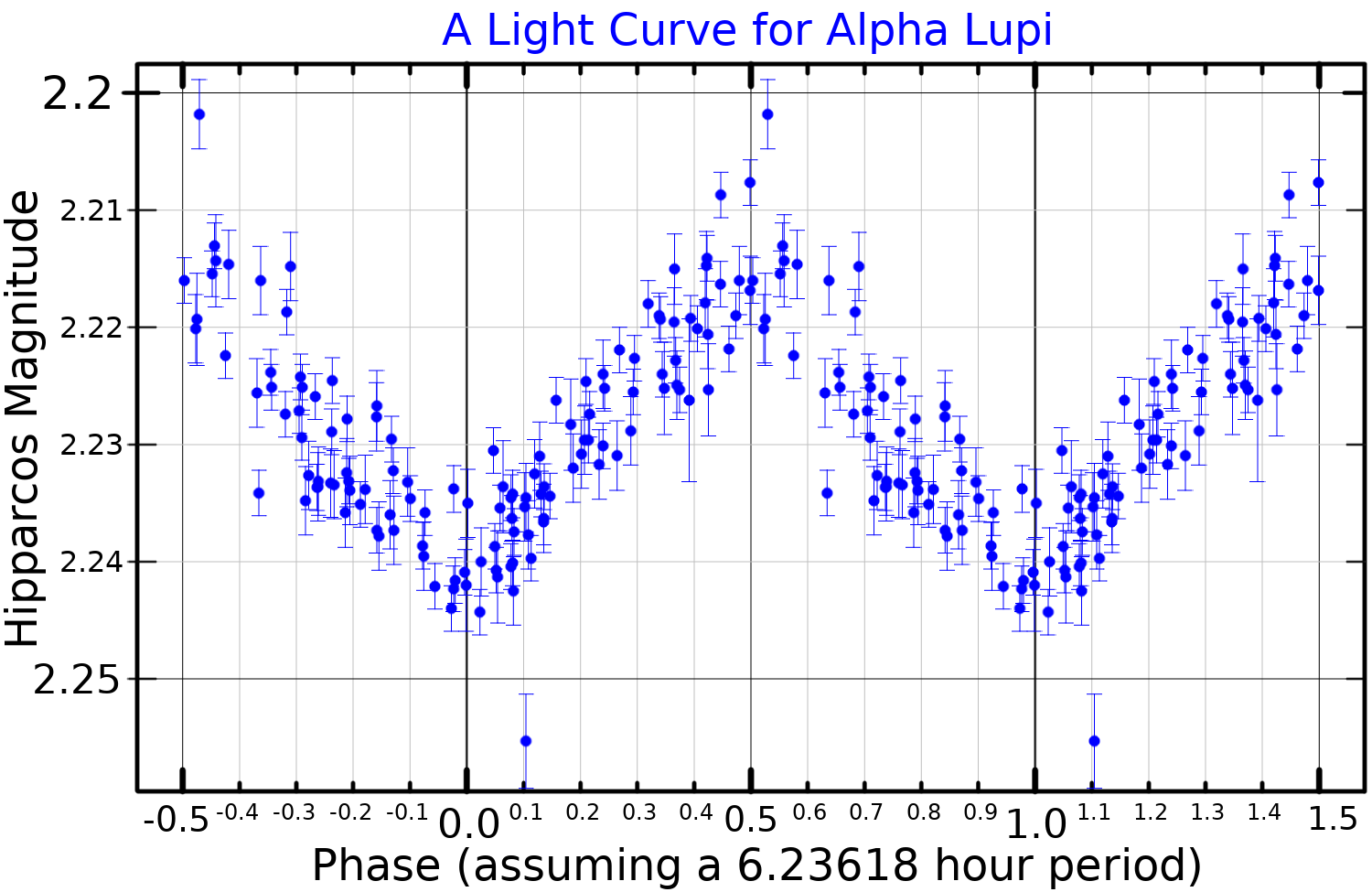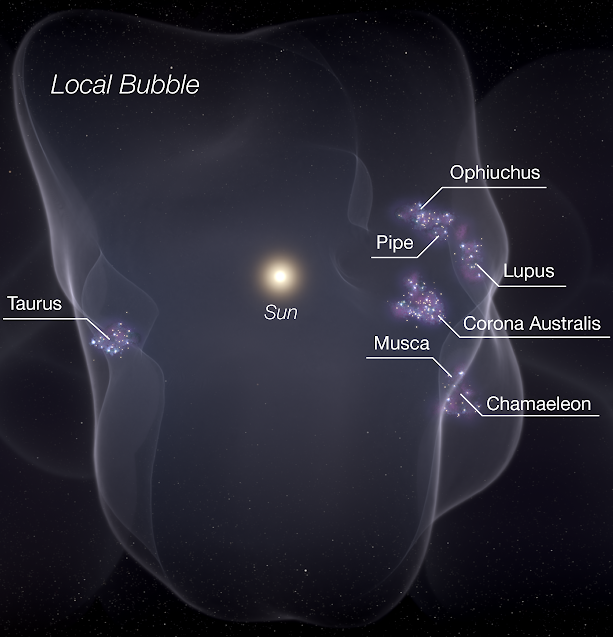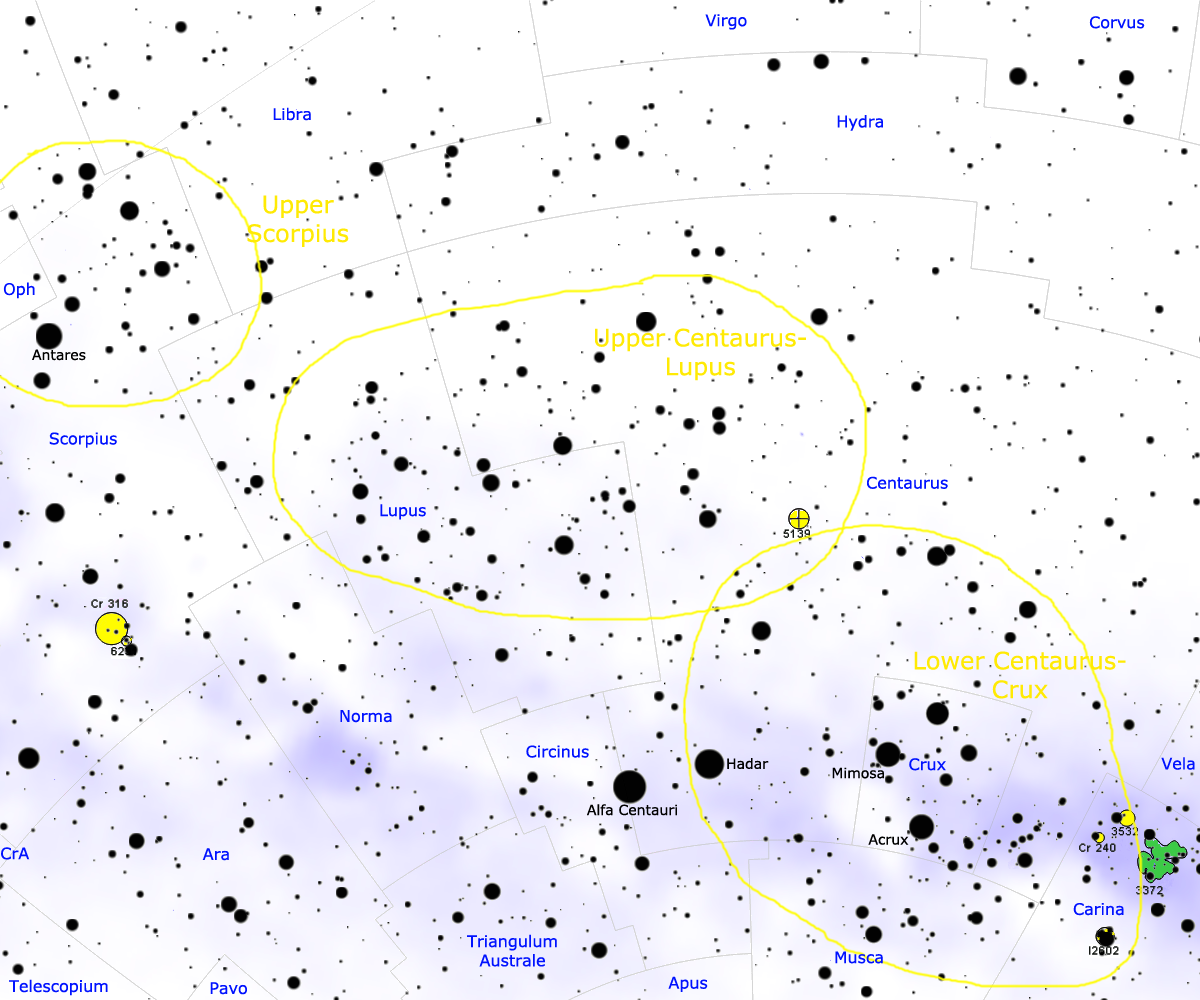|
Alpha Lupi
Alpha Lupi (α Lupi, α Lup) is a blue giant star, and the brightest star in the southern constellation of Lupus. According to the Bortle Dark-Sky Scale, its apparent visual magnitude of 2.3 makes it readily visible to the naked eye even from highly light-polluted locales. Based upon parallax measurements made during the Hipparcos mission, the star is around from the solar system. It is one of the nearest supernova candidates. Characteristics Alpha Lupi is a giant star with a stellar classification of B1.5 III. It has about ten times the mass of the sun (~) yet is radiating 25,000 times the Sun's luminosity. The outer atmosphere has an effective temperature of 21,820 K, which gives it the blue-white glow of a B-type star. In 1956 it was identified as a Beta Cephei variable by Bernard Pagel and colleagues, which means it undergoes periodic changes in luminosity because of pulsations in the atmosphere. The variability period is 0.29585 days, or just over 7 hours, ... [...More Info...] [...Related Items...] OR: [Wikipedia] [Google] [Baidu] |
Lupus (constellation)
Lupus is a constellation of the mid-Southern Sky. Its name is Latin for wolf. Lupus was one of the 48 constellations listed by the 2nd-century astronomer Ptolemy, and it remains one of the 88 modern constellations but was long an asterism associated with the just westerly, larger constellation Centaurus. History and mythology In ancient times, the constellation was considered an asterism within Centaurus, and was considered to have been an arbitrary animal, killed, or about to be killed, on behalf of, or for, Centaurus. An alternative visualization, attested by Eratosthenes, saw this constellation as a wineskin held by Centaurus. It was not separated from Centaurus until Hipparchus of Bithynia named it ( meaning "beast") in the 2nd century BC. The Greek constellation is probably based on the Babylonian figure known as the Mad Dog (UR.IDIM). This was a strange hybrid creature that combined the head and torso of a man with the legs and tail of a lion (the cuneiform sign 'UR' ... [...More Info...] [...Related Items...] OR: [Wikipedia] [Google] [Baidu] |
Stellar Classification
In astronomy, stellar classification is the classification of stars based on their stellar spectrum, spectral characteristics. Electromagnetic radiation from the star is analyzed by splitting it with a Prism (optics), prism or diffraction grating into a spectrum exhibiting the Continuum (spectrum), rainbow of colors interspersed with spectral lines. Each line indicates a particular chemical element or molecule, with the line strength indicating the abundance of that element. The strengths of the different spectral lines vary mainly due to the temperature of the photosphere, although in some cases there are true abundance differences. The ''spectral class'' of a star is a short code primarily summarizing the ionization state, giving an objective measure of the photosphere's temperature. Most stars are currently classified under the Morgan–Keenan (MK) system using the letters ''O'', ''B'', ''A'', ''F'', ''G'', ''K'', and ''M'', a sequence from the hottest (''O'' type) to the coo ... [...More Info...] [...Related Items...] OR: [Wikipedia] [Google] [Baidu] |
Root (Chinese Constellation)
The Root mansion (氐宿, pinyin: Dī Xiù) is one of the Twenty-eight mansions of the Chinese constellation Traditional Chinese astronomy has a system of dividing the celestial sphere into asterisms or constellations, known as "officials" (Chinese ''xīng guān''). The Chinese asterisms are generally smaller than the constellations of Hellenistic t ...s. It is one of the eastern mansions of the Azure Dragon. Asterisms {{DEFAULTSORT:Root (Chinese Constellation) Chinese constellations ... [...More Info...] [...Related Items...] OR: [Wikipedia] [Google] [Baidu] |
Chinese Astronomy
Astronomy in China has a long history stretching from the Shang dynasty, being refined over a period of more than 3,000 years. The ancient Chinese people have identified stars from 1300 BCE, as Chinese star names later categorized in the twenty-eight mansions have been found on oracle bones unearthed at Anyang, dating back to the mid-Shang dynasty. The core of the "mansion" (宿 ''xiù'') system also took shape around this period, by the time of King Wu Ding (1250–1192 BCE). Detailed records of astronomical observations began during the Warring States period (fourth century BCE) and flourished from the Han period onward. Chinese astronomy was equatorial, centered on close observation of circumpolar stars, and was based on different principles from those in traditional Western astronomy, where heliacal risings and settings of zodiac constellations formed the basic ecliptic framework. Joseph Needham has described the ancient Chinese as the most persistent and accurate obser ... [...More Info...] [...Related Items...] OR: [Wikipedia] [Google] [Baidu] |
Subtropics
The subtropical zones or subtropics are geographical and climate zones to the north and south of the tropics. Geographically part of the temperate zones of both hemispheres, they cover the middle latitudes from to approximately 35° north and south. The horse latitudes lie within this range. Subtropical climates are often characterized by hot summers and mild winters with infrequent frost. Most subtropical climates fall into two basic types: humid subtropical (Koppen climate Cfa), where rainfall is often concentrated in the warmest months, for example Southeast China and the Southeastern United States, and dry summer or Mediterranean climate (Koppen climate Csa/Csb), where seasonal rainfall is concentrated in the cooler months, such as the Mediterranean Basin or Southern California. Subtropical climates can also occur at high elevations within the tropics, such as in the southern end of the Mexican Plateau and in Da Lat of the Vietnamese Central Highlands. The six climate cl ... [...More Info...] [...Related Items...] OR: [Wikipedia] [Google] [Baidu] |
Tropics
The tropics are the regions of Earth surrounding the Equator. They are defined in latitude by the Tropic of Cancer in the Northern Hemisphere at N and the Tropic of Capricorn in the Southern Hemisphere at S. The tropics are also referred to as the tropical zone and the torrid zone (see geographical zone). In terms of climate, the tropics receive sunlight that is more direct than the rest of Earth and are generally hotter and wetter as they aren't affected as much by the solar seasons. The word "tropical" sometimes refers to this sort of climate in the zone rather than to the geographical zone itself. The tropical zone includes deserts and snow-capped mountains, which are not tropical in the climatic sense. The tropics are distinguished from the other climatic and biomatic regions of Earth, which are the middle latitudes and the polar regions on either side of the equatorial zone. The tropics constitute 40% of Earth's surface area and contain 36% of Earth's landmass. , the ... [...More Info...] [...Related Items...] OR: [Wikipedia] [Google] [Baidu] |
Local Bubble
The Local Bubble, or Local Cavity, is a relative cavity in the interstellar medium (ISM) of the Orion Arm in the Milky Way. It contains the closest of celestial neighbours and among others, the Local Interstellar Cloud (which contains the Solar System), the neighbouring G-Cloud, the Ursa Major Moving Group ( the closest stellar moving group) and the Hyades (the nearest open cluster). It is at least 300 light years across, and is defined by its neutral-hydrogen density of about 0.05 atoms/cm3, or approximately one tenth of the average for the ISM in the Milky Way (0.5 atoms/cm3), and one sixth that of the Local Interstellar Cloud (0.3 atoms/cm3). The exceptionally sparse gas of the Local Bubble is the result of supernovae that exploded within the past ten to twenty million years. Geminga, a pulsar in the constellation Gemini, was once thought to be the remnant of a single supernova that created the Local Bubble, but now multiple supernovae in subgroup B1 ... [...More Info...] [...Related Items...] OR: [Wikipedia] [Google] [Baidu] |
Stellar Association
A stellar association is a very loose star cluster, looser than both open clusters and globular clusters. Stellar associations will normally contain from 10 to 100 or more stars. The stars share a common origin, but have become gravitationally unbound and are still moving together through space. Associations are primarily identified by their common movement vectors and ages. Identification by chemical composition is also used to factor in association memberships. Stellar associations were first discovered by the Soviet Armenian astronomer Victor Ambartsumian in 1947. The conventional name for an association uses the names or abbreviations of the constellation (or constellations) in which they are located; the association type, and, sometimes, a numerical identifier. Types Victor Ambartsumian first categorized stellar associations into two groups, OB and T, based on the properties of their stars. A third category, R, was later suggested by Sidney van den Bergh for associations th ... [...More Info...] [...Related Items...] OR: [Wikipedia] [Google] [Baidu] |
Scorpius–Centaurus Association
The Scorpius–Centaurus association (sometimes called Sco–Cen or Sco OB2) is the nearest OB association to the Sun. This stellar association is composed of three subgroups (Upper Scorpius, Upper Centaurus–Lupus, and Lower Centaurus–Crux) and its distance is about 130 parsecs or 420 light-years. Using improved Hipparcos data, Rizzuto and colleagues analysed nearby stars more closely, bringing the number of known members to 436. They doubt the need to add a subclassification because they found a more continuous spread of stars. The Sco–Cen subgroups range in age from 11 million years (Upper Scorpius) to roughly 15 million years (Upper Centaurus–Lupus and Lower Centaurus–Crux). Many of the bright stars in the constellations Scorpius, Lupus, Centaurus, and Crux are members of the Sco–Cen association, including Antares (the most massive member of Upper Scorpius), and most of the stars in the Southern Cross. Hundreds of stars have been identified as members of Sco-Cen, ... [...More Info...] [...Related Items...] OR: [Wikipedia] [Google] [Baidu] |
Proper Motion
Proper motion is the astrometric measure of the observed changes in the apparent places of stars or other celestial objects in the sky, as seen from the center of mass of the Solar System, compared to the abstract background of the more distant stars. The components for proper motion in the equatorial coordinate system (of a given epoch, often J2000.0) are given in the direction of right ascension (''μ''α) and of declination (''μ''δ). Their combined value is computed as the ''total proper motion'' (''μ''). It has dimensions of angle per time, typically arcseconds per year or milliarcseconds per year. Knowledge of the proper motion, distance, and radial velocity allows calculations of an object's motion from our star system's frame of reference and its motion from the galactic frame of reference – that is motion in respect to the Sun, and by coordinate transformation, that in respect to the Milky Way. Introduction Over the course of centuries, stars appear t ... [...More Info...] [...Related Items...] OR: [Wikipedia] [Google] [Baidu] |
Bernard Pagel
Bernard Ephraim Julius Pagel FRS (4 January 1930 – 14 July 2007) was a British astrophysicist who worked on the measurement and interpretation of elemental abundances in stars and galaxies. Life The son of physician and medical historian Walter Pagel and grandson of German physician Julius Leopold Pagel, he was born in Berlin in 1930, but moved with his family to Britain in 1933 to avoid the growing Jewish persecution in Germany at that time. He was educated at Merchant Taylors' School in Northwood and at Sidney Sussex College, Cambridge, from which he graduated with first-class honours in Physics in 1950. He remained in Cambridge to pursue his doctoral studies, obtaining his PhD in 1955. He was a Research Fellow at Sidney Sussex college from 1953-1956. In 1956, he moved to the Royal Greenwich Observatory at Herstmonceux Castle where he spent the greater part of his career, eventually progressing to the grade of Deputy Chief Scientific Officer. In 1967, he became a ... [...More Info...] [...Related Items...] OR: [Wikipedia] [Google] [Baidu] |





.jpg)
